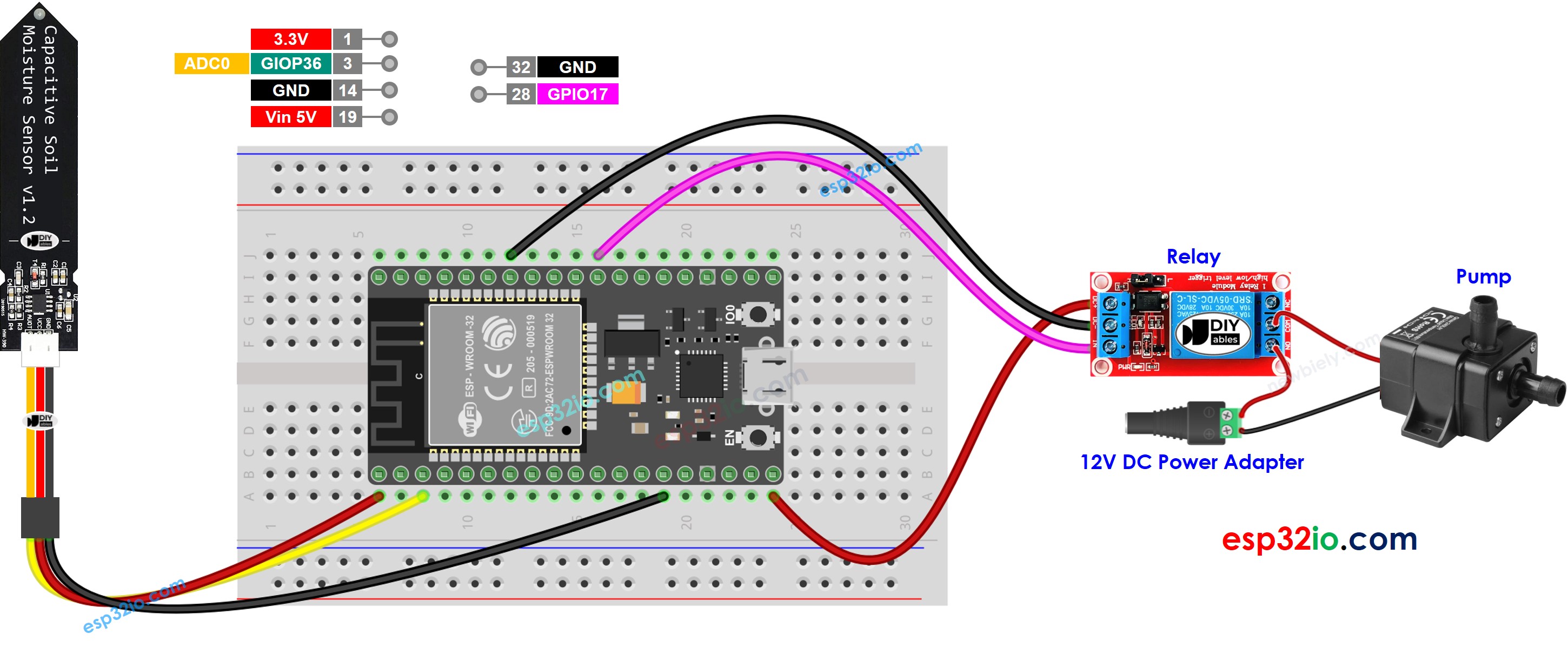ESP32 - Soil Moisture Sensor Pump
In this tutorial, We are going to learn how to use the ESP32 to control the pump according to the value read from the capacitive soil moisture sensor.
Hardware Used In This Tutorial
Or you can buy the following kits:
| 1 | × | DIYables ESP32 Starter Kit (ESP32 included) | |
| 1 | × | DIYables Sensor Kit (30 sensors/displays) | |
| 1 | × | DIYables Sensor Kit (18 sensors/displays) |
Buy Note: Numerous capacitive soil moisture sensors available in the market are of poor quality, regardless of the version. We strongly advise purchasing the sensor with TLC555I Chip from the DIYables brand via the link above; we conducted tests, and it performed reliably.
Introduction to soil moisture sensor and Pump
If you do not know about pump and soil moisture sensor (pinout, how it works, how to program ...), learn about them in the following tutorials:
- ESP32 - Soil Moisture Sensor tutorial
- ESP32 - Controls Pump tutorial
How It Works
ESP32 periodically reads the value from the capacitive soil moisture sensor. Based on the soil moisture value, it will take the following actions:
- If the soil moisture value is below a threshold, ESP32 automatically activates a relay to turn a pump on.
- Otherwise, ESP32 automatically deactivates a relay to turn a pump off.
Wiring Diagram

This image is created using Fritzing. Click to enlarge image
If you're unfamiliar with how to supply power to the ESP32 and other components, you can find guidance in the following tutorial: The best way to Power ESP32 and sensors/displays.
ESP32 Code
Quick Instructions
- If this is the first time you use ESP32, see how to setup environment for ESP32 on Arduino IDE.
- Do calibration to determine the wet-dry THRESHOLD, see ESP32 - Calibrates Soil Moisture Sensor
- Update the calibrated value to THRESHOLD in the code
- Open Serial Monitor on Arduino IDE
- Upload the code to ESP32
- Check out the result on Serial Monitor.
Code Explanation
Read the line-by-line explanation in the comment lines of the source code!
※ NOTE THAT:
This tutorial uses the analogRead() function to read values from an ADC (Analog-to-Digital Converter) connected to a soil moisture sensor. The ESP32 ADC is good for projects that do NOT need high accuracy. However, for projects that need precise measurements, please note:
- The ESP32 ADC is not perfectly accurate and might need calibration for correct results. Each ESP32 board can be a bit different, so you need to calibrate the ADC for each individual board.
- Calibration can be difficult, especially for beginners, and might not always give the exact results you want.
For projects that need high precision, consider using an external ADC (e.g ADS1115) with the ESP32 or using an Arduino, which has a more reliable ADC. If you still want to calibrate the ESP32 ADC, refer to ESP32 ADC Calibration Driver
Video Tutorial
Making video is a time-consuming work. If the video tutorial is necessary for your learning, please let us know by subscribing to our YouTube channel , If the demand for video is high, we will make the video tutorial.
